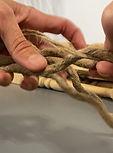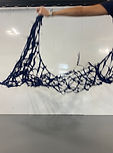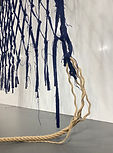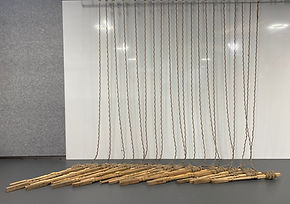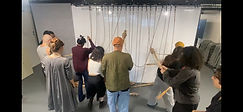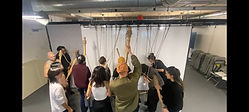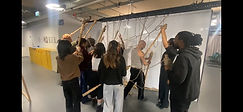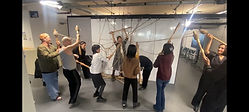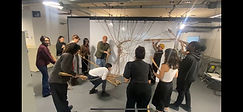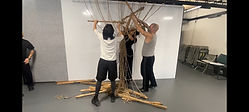Writing on Heritage
Fishing nets introduce this new body of work exploring themes of tradition, craft and migration. Maltese traditional fishing boats called Luzzu date back to ancient Phoenicians in 700 BC. They had eyes painted on the bow, said to protect the fishermen at sea. I metaphorically cast the net to capture and reinterpret my cultural heritage through a contemporary lens. It comments on the Maltese fishing industry which has been a constant source of income for the local people for many centuries. It also references the current situation of migrants seeking refuge by dangerously crossing seas in fishing boats, clinging on to fishing nets when their boats deflate, and they end up in Malta.
Making the net involves a repetitive and methodical process of unravelling, looping, tying and knotting. It imitates an athletic performance, using the whole of my body to stretch, pull, throw and tie the very long strips of fabric. Care is taken to ensure the diagonal patterns are equally spaced out. These negative spaces are filled with irony; while a net is made to catch and trap, it still allows its prey to breathe.
The net is made from repurposed fabric. A conscious decision was made, not to use nylon twine so as not to engage in the conversation of pollution, ghost nets and plastic waste. The act of knotting also extends to the cultural tradition of Maltese bobbin lacemaking, bizzilla. While generations of Maltese fishermen knot and repair their nets, narrating stories and singing folk songs, similarly, their wives, mothers and daughters would gather to make lace, threading narratives, songs and prayers into their work.
A large-scale interactive installation of ropes and banisters represent the linen threads and bobbins respectively. The only instruction given is to weave their way through it. They harmoniously fall into a rhythm, collaboratively, carefully and instinctively negotiating their way around each other. Bending, reaching, ducking and twisting, they avoid tension, forming new interesting shapes. The participants decide when they have finished their part of the performance and slowly, individually put down their banister and walk away silently. What is left of the final woven rope is very sculptural and suggestive of a boat’s tangled ropes on the mast, it seems to be poised ready to take a bow.
